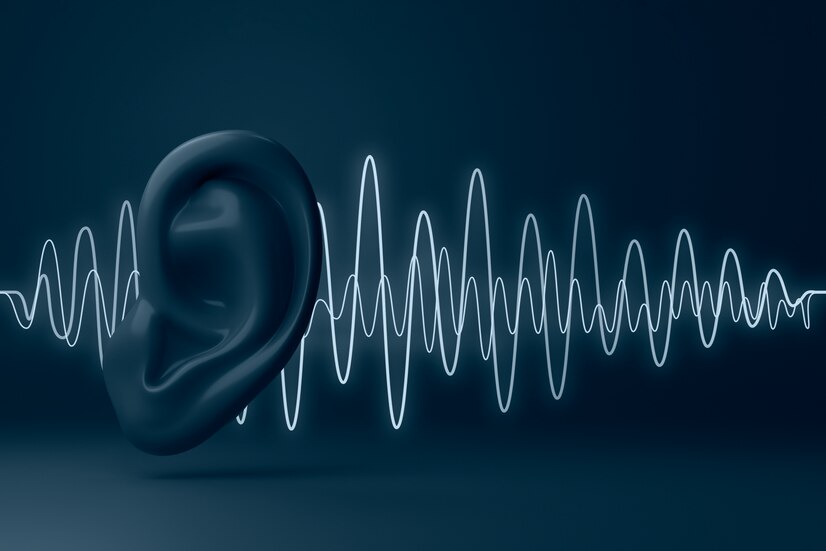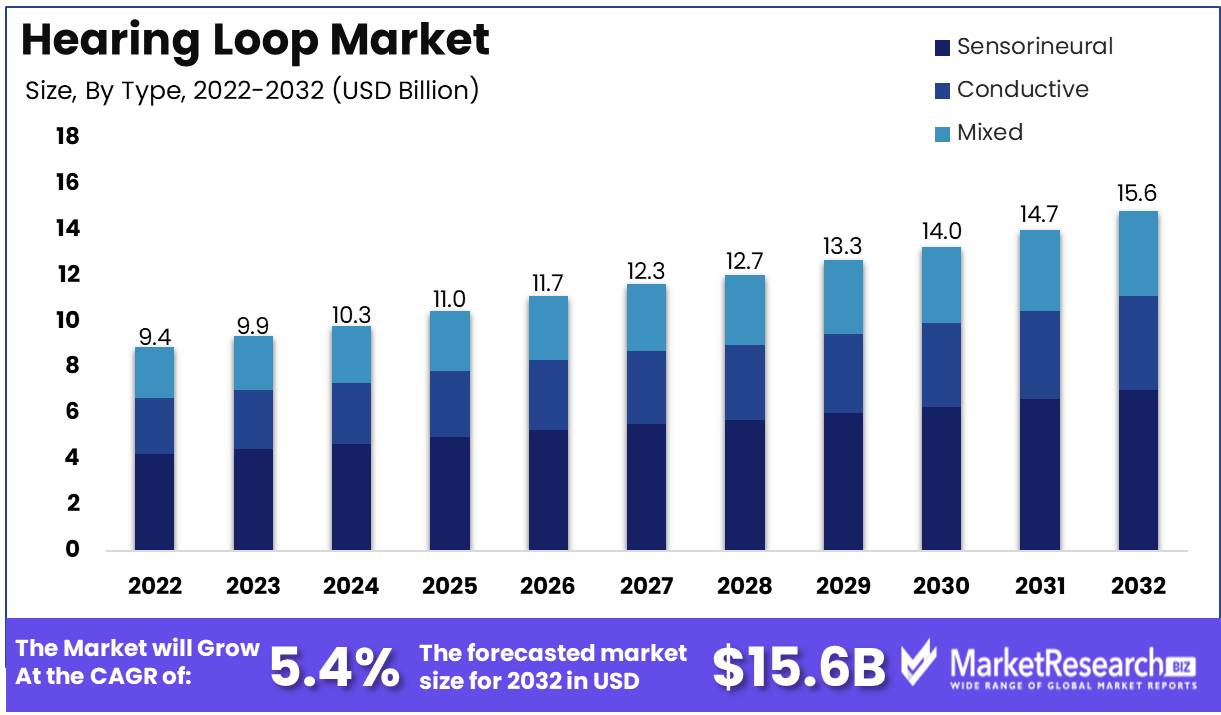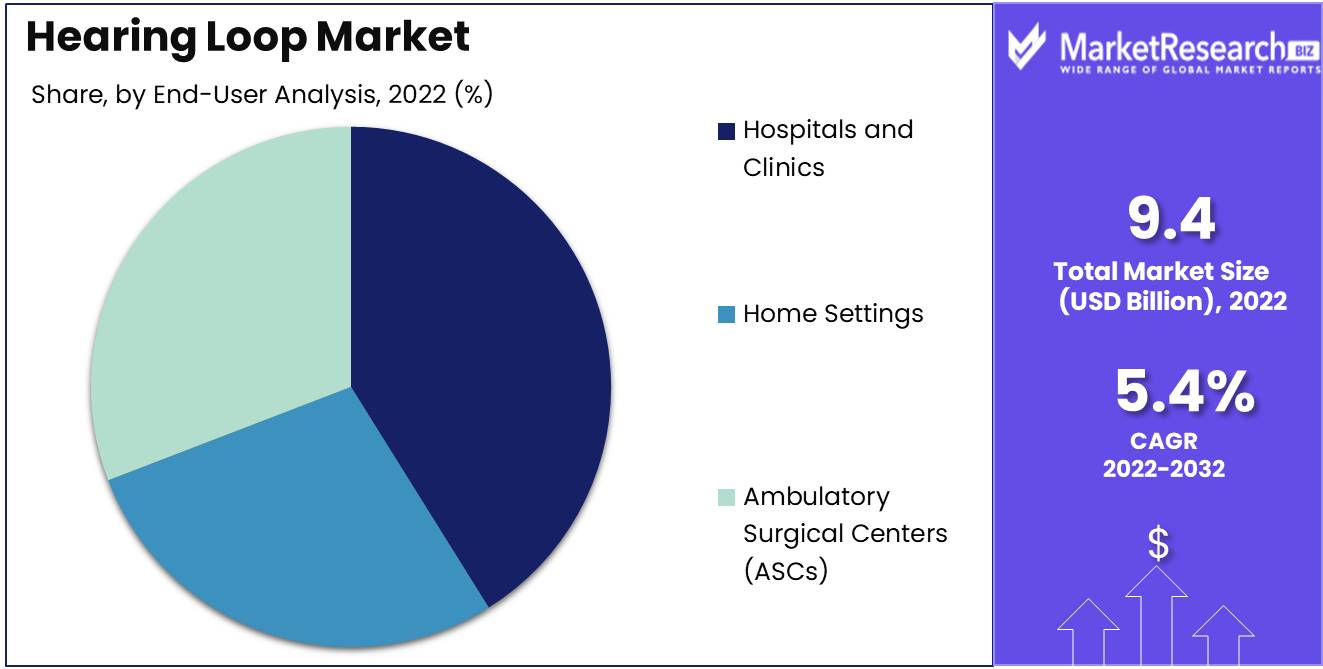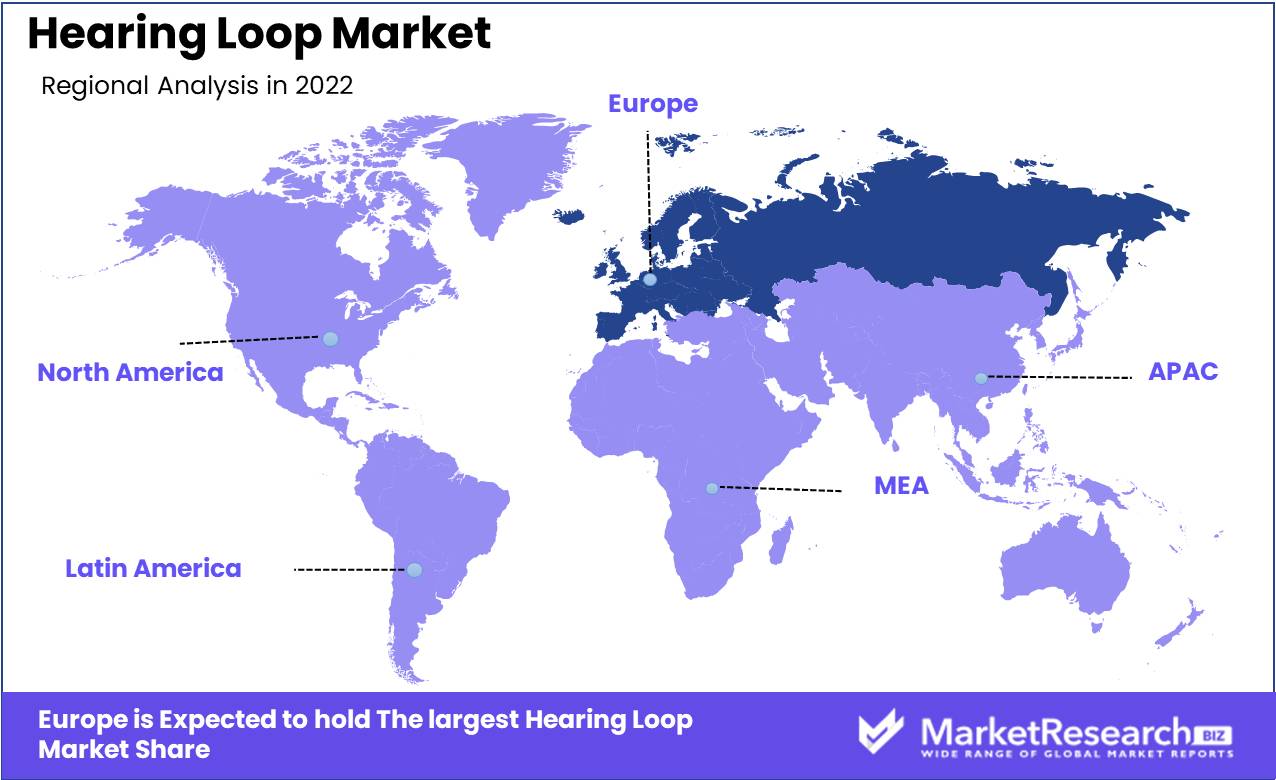
Hearing Loop Market By Type (Sensorineural, Conductive, Mixed), By End-User (Hospitals and Clinics, Home Settings, and Others), By Signal Transmit Type (Radio Wave, Light Wave, and Others), By Patient Type (Adult, Paediatrics), By Region And Companies - Industry Segment Outlook, Market Assessment, Competition Scenario, Trends, And Forecast 2023-2032
-
37418
-
June 2023
-
137
-
-
This report was compiled by Correspondence Linkedin | Detailed Market research Methodology Our methodology involves a mix of primary research, including interviews with leading mental health experts, and secondary research from reputable medical journals and databases. View Detailed Methodology Page
-
Report Overview
Hearing Loop Market size is expected to be worth around USD 15.6 Bn by 2032 from USD 9.4 Bn in 2022, growing at a CAGR of 5.4% during the forecast period from 2023 to 2032.
The demand for hearing aides and assistive listening devices has skyrocketed, the Global Hearing Loop Market has acquired enormous significance. Hearing loops utilize electromagnetic radiation to transmit audio signals directly to a hearing aids or cochlear implants. A loop wire, an amplifier, and an audio source are included in the system. The objective of the Global Hearing Loop Market is to enhance the quality of life of people with hearing loss by making it simpler for them to communicate in public spaces.

Hearing loop technology enables individuals with hearing loss to hear communication in noisy environments more distinctly and to comprehend it more readily. It is essential for individuals who struggle to hear in congested environments, meetings, conferences, and even places of devotion. A hearing loop system can also enhance their mental health and social life by enabling them to participate in events and engage in conversation with others.
The Hearing Loop Market has witnessed significant technological advancements in recent years. Innovations such as intelligent mobile applications for hearing loop systems have made it simpler for users to fine-tune the audio output according to their preferences and make necessary adjustments. In addition, wireless hearing loops have been created, allowing hearing loop systems to be implemented without the need for physical wires and making the technology more accessible.
Regarding the security of electromagnetic fields and the cost of hearing loop systems, the Hearing Loop Market has raised ethical concerns. The long-term effects on public health of hearing loop systems' use of powerful electromagnetic fields are a cause for concern. In addition, the high price of hearing loop systems has prevented low-income communities from having access to the technology. Manufacturers and policymakers must work to make hearing loop systems more cost-effective and implement safety measures to mitigate potential health risks.
Driving factors
Enhanced sensibility and demand for accessibility
Due to the rising awareness of hearing loss and the demand for accessibility for people with hearing impairments, the Global Hearing Loop Market is expanding rapidly. Demand for hearing loop technology, which provides clear and direct sound to hearing aids, is consistently increasing as more people recognize the significance of inclusivity.
Technological Developments and New Product Development
Constant technological advancements have propelled the expansion of the Hearing Loop Market. Manufacturers are continuously enhancing and refining their products, resulting in a wider selection of options and enhanced performance. These developments have spurred the implementation of hearing loop technology in a variety of public venues and facilities.
Regulatory Standards and Compliance
In many countries, the implementation of regulatory requirements for hearing assistance systems has had a significant impact on the Hearing Loop Market. Hearing assistance systems are mandated for public venues and facilities, resulting in the increased adoption of hearing loop technology. Stricter regulations have contributed to the expansion of the market.
Influence of Emerging Technologies on Consumer Conduct
Emerging technologies and alterations in consumer behavior may also influence the Hearing Loop Market. Innovative developments may disrupt the competitive landscape, but businesses that remain ahead of the curve and adopt new technologies will prosper. In addition, as more individuals recognize the significance of accessibility, the demand for hearing loop technology is anticipated to increase.
Restraining Factors
Overcoming Installation and Maintenance Costs
While the installation and maintenance costs of hearing loop systems can be prohibitive, there are ways to overcome these challenges. One solution is to work with vendors that provide turnkey installation and maintenance services. Partnering with these vendors can save considerable time and money, allowing organizations to implement hearing loop systems without breaking the bank.
Compatibility Issues with Hearing Aids and Cochlear Implants
Another challenge facing hearing loop systems is the potential for compatibility issues with hearing aids and cochlear implants. Certain types of hearing aids and cochlear implants may not be compatible with hearing loop systems due to differences in technology. Additionally, users may experience difficulties connecting to hearing loop systems or may receive feedback or interference during use.
Overcoming Compatibility Issues
To overcome these compatibility issues, it is important to design hearing loop systems that are compatible with a wide range of hearing aids and cochlear implants. Working with manufacturers to create hearing aids and cochlear implants that are compatible with hearing loop systems can also be an effective approach. Finally, regular testing and maintenance of the hearing loop system can identify any interference or other issues, allowing for quick resolution and improved compatibility with hearing aids and cochlear implants.
Competition from Alternative Assistive Listening Technologies
Finally, hearing loop systems face competition from a range of alternative assistive listening technologies, such as FM systems and infrared systems. These technologies offer advantages such as greater flexibility and mobility, as well as easier installation in certain settings.
Overcoming Competition from Alternative Technologies
To compete effectively with these technologies, hearing loop systems need to continue improving and innovating. This may involve developing new features and capabilities, such as wireless connectivity and smartphone integration. Additionally, hearing loop systems need to be effectively marketed to ensure that customers are aware of their benefits and advantages over alternative technologies. By highlighting the unique advantages and benefits of hearing loop systems, organizations can position them as a compelling choice in the market.
Type Analysis
The sensorineural segment dominates the global hearing loop market with a sizeable share. The segment employs cutting-edge technology that has proven to be extremely beneficial for patients with hearing loss. This segment's sophisticated features, which include noise reduction, feedback cancellation, and multiple setting options, have contributed to its growth. Due to the economic growth of emergent economies, the sensorineural segment has seen significant adoption. This segment is utilized frequently in hospitals, clinics, and other healthcare facilities. In addition, the increase in disposable income in these emerging economies has led to a rise in the use of innovative hearing aids.
Consumers have demonstrated an increasing propensity to utilize sensorineural segment solutions. They are now more cognizant of the sophisticated technology incorporated into these solutions, which enables them to achieve improved hearing outcomes. As the global population ages, the sensorineural segment is expected to maintain its rapid expansion.
End-User Analysis
The hospital and clinic segment dominates the worldwide Hearing Loop Markets. This segment offers a variety of hearing solutions to its consumers, providing them with numerous options. These solutions' use of sophisticated technology has helped hospitals and clinics acquire a significant market share. The adoption of the hospital and clinic segment has increased as a result of economic growth in emerging economies. In these economies, hospitals and institutions have begun adopting cutting-edge technology to improve patient care. This has increased the demand for hearing aids in hospitals and clinics.
In recent years, the consumer behavior and trend towards the hospital and clinic segment have been positive. Patients' awareness of the technology used in these segments has increased, resulting in greater adoption. With the advancement of technology in hospitals and clinics, this market segment is poised for future growth.

Patient Type Analysis
On the global Hearing Loop Markets, the greatest segment is adults. This is primarily because the global population is aging. In this age group, the sophisticated solutions offered in the adult segment have proved to be highly effective in treating hearing loss. With an expanding number of elderly persons pursuing advanced hearing solutions, economic development in emerging economies has pushed the adoption of the adult segment. Moreover, the increase in disposable income in these economies has led to the adoption of innovative hearing solutions.
Due to the efficacy of these solutions in treating hearing loss, the consumer behavior and trend towards the adult segment have been positive. Adults are increasingly interested in incorporating cutting-edge technology into their hearing aids to improve hearing outcomes. As the global population ages, the adult market segment is projected to experience accelerated expansion in the future years.
Key Market Segments
By Type
- Sensorineural
- Conductive
- Mixed
By End-User
- Hospitals and Clinics
- Home Settings
- Ambulatory Surgical Centers (ASCs)
By Signal Transmit Type
- Radio Wave
- Light Wave
- Bluetooth
- Electromagnetic Wave
By Patient Type
- Adult
- Paediatrics
Growth Opportunity
Integration of Hearing Loops in Additional Public Locations
Hearing Loop Markets has experienced significant growth in recent years, and this trend is anticipated to continue into the foreseeable future. Integration of hearing loops in more public spaces, such as theaters, churches, airports, and public transportation, is expanding significantly, resulting in a worldwide increase in demand for hearing loop systems.
Creation of Wireless and Mobile Loop Solutions
Hearing Loop Markets is fuelled by the development of wireless and portable loop solutions, which offer consumers greater flexibility and convenience. Wireless loops allow users to connect their hearing aides or cochlear implants to audio systems or mobile devices without using tangible cables, resulting in a more seamless experience. In contrast, portable loops allow for the temporary installation of hearing loop systems, which is particularly useful in situations such as conferences and public events.
Collaboration between Manufacturers of Hearing Loops and Audiology Professionals
Collaboration between hearing loop manufacturers and audiologists also contributes to the expansion of Hearing Loop Markets. Manufacturers are collaborating closely with audiologists to develop hearing loop systems that meet the requirements of consumers and offer the best hearing experience possible. This partnership has resulted in the development of innovative new technologies, such as Bluetooth-enabled hearing loops and adaptive loop systems, which are expanding Hearing Loop Market systems.
Initiatives for the Instruction of Hearing Loop Benefits
In addition to technological advancements, educational initiatives on the advantages of hearing loops play a significant role in the market's expansion. Many individuals with hearing loss are unaware of the benefits of hearing loop systems; however, education campaigns are assisting to increase awareness of the technology and its benefits. Through these campaigns, an increasing number of individuals are becoming aware that hearing loops can enhance their quality of life and are pursuing hearing loop solutions.
Latest Trends
Loop Technology Integration in Hearing Aids and Cochlear Implants
The incorporation of loop technology into hearing aides and cochlear implants has revolutionized the communication of the hearing-impaired. Loop technology, also known as induction loop systems, eliminates external pollution by transmitting sound directly to these devices. This integration enhances the audio experience and communication for those with hearing impairments. It is a discreet, practical, and cost-effective solution that eliminates the need for additional apparatus. Hearing aid manufacturers are increasingly offering devices that are loop-enabled, making loop technology more accessible to those in need.
Extension of Loop System Applications to Outside of Public Venues
Historically, large public venues were where loop systems were installed, but their applications have since expanded. Institutions, offices, and private residences are employing loop technology to aid deaf individuals. Loop systems in places of worship, institutions, and workplaces improve communication and participation in daily activities. By implementing loop technology, businesses and organizations ensure that all visitors and employees can hear distinctly, thereby fostering greater inclusion and enhancing the overall experience. Residential loop systems have also acquired popularity, providing homeowners with inexpensive hearing solutions. The quantity of loop installations continues to increase as accessibility improves.
Loop Systems with Superior Noise Reduction Capabilities
The challenges of outdoor and raucous environments are addressed by Loop systems equipped with cutting-edge noise reduction technology. These systems reduce background noise using digital signal processing, allowing audiences to concentrate on the desired sound. This technology enables hearing-impaired individuals to engage in previously challenging activities, such as following conversations in public or attending events in loud environments. Loop systems with sophisticated noise reduction features are notably popular in outdoor areas, transportation systems, and sports venues.
Regional Analysis
The Hearing Loop Market is dominated by Europe. Europe currently dominates Hearing Loop Markets, and one of the reasons for this is the continent's extensive history with the technology. Since the installation of the first hearing loop system in a Swedish church in 1947, Europe has embraced hearing loops, with many countries mandating their use in public spaces. This level of government support has contributed to Europe's leadership position in the discipline.
Europe's market dominance in hearing loops can also be attributed to the availability of high-quality technology and installation services. They have acquired a reputation for producing dependable, high-quality systems. Europe's stringent implementation standards guarantee that hearing circuits are installed correctly and function as intended.
Europe takes a different approach to hearing circuits than other regions, such as the United States. In the United States, FM systems and other assistive listening devices are utilized more frequently than hearing loops. This disparity may be attributable to a dearth of government support and a reduced level of awareness and education regarding the advantages of hearing loops.
However, the tide may be turning as more European organizations actively promote hearing circuits and efforts are made to implement them in new settings such as airports and train stations. Additionally, hearing loops are becoming increasingly popular in countries such as Australia and New Zealand. As awareness of the technology grows and the elderly population drives demand for effective hearing solutions, Hearing Loop Markets appears to have a bright future.

Key Regions and Countries
North America
- US
- Canada
- Mexico
Western Europe
- Germany
- France
- The UK
- Spain
- Italy
- Portugal
- Ireland
- Austria
- Switzerland
- Benelux
- Nordic
- Rest of Western Europe
Eastern Europe
- Russia
- Poland
- The Czech Republic
- Greece
- Rest of Eastern Europe
APAC
- China
- Japan
- South Korea
- India
- Australia & New Zealand
- Indonesia
- Malaysia
- Philippines
- Singapore
- Thailand
- Vietnam
- Rest of APAC
Latin America
- Brazil
- Colombia
- Chile
- Argentina
- Costa Rica
- Rest of Latin America
Middle East & Africa
- Algeria
- Egypt
- Israel
- Kuwait
- Nigeria
- Saudi Arabia
- South Africa
- Turkey
- United Arab Emirates
- Rest of MEA
Key Players Analysis
Hearing loops are intended to improve the listening experience for individuals with hearing loss. As the demand for improved technology to enhance the quality of life for those with hearing impairments rises, the global hearing loop market is anticipated to expand significantly over the next few years. The market is extremely competitive and dominated by a small number of major competitors.
Owen Mumford, a company that specializes in medical devices and has a strong focus on enhancing the lives of individuals with hearing loss, is one of the market leaders. Listen Technologies, another significant participant, offers a variety of assistive listening devices, including hearing loops.
Comfort Audio, Ampetronic, and Williams Sound are also significant participants in the global hearing loop market. These businesses offer a variety of hearing loop products and services, such as loop drivers, amplifiers, and receivers.
As Hearing Loop Market technology continues to expand, it is likely that new entrants will emerge and challenge the dominance of the current market leaders. Those who have a strong reputation for producing high-quality, dependable products will likely continue to dominate the market in the foreseeable future. The significance of keeping abreast of hearing loop market developments, including new products, trends, and key participants. By providing timely, accurate, and engaging information, I am able to assist companies in the hearing loop market in connecting with their target audience and establishing themselves as industry leaders.
Top Key Players in Hearing Loop Market
- Owen Mumford
- Opus Technologies (U.S.)
- Ampetronic (U.K.)
- Geemarc (U.K.)
- Audio Directions (U.S.)
- Bo Edin AB (Sweden)
- Contacta, Inc. (U.S.)
- inLOOP, LLC (U.S.)
- Loop America (U.S.)
- Oval Window Audio (U.S.)
- Williams AV, LLC (U.S.)
- Other Key Players
Recent Development
In 2021, Widex, a Danish hearing aid company specializing in hearing loops, was acquired by Starkey Hearing Technologies making headlines. The acquisition allowed Starkey to extend its presence in the hearing loop market, which has been consistently expanding in recent years.
In 2022, GN Hearing acquired Oticon, another Danish hearing aid company that specializes in hearing loops. The acquisition was viewed as a strategic move by GN Hearing because it enabled them to expand their product line and acquire a competitive edge in the market.
In 2023, Cochlear has announced that it is presently conducting Phase III clinical trials on a new implantable hearing loop. The implant is anticipated to significantly enhance the sound quality of hearing aids and has the potential to revolutionize the hearing aid industry.
The Global Hearing Loop Market is poised for continued growth and innovation in light of these recent developments. As technology continues to advance, we can anticipate even more thrilling innovations in the coming years.
Report Scope:
Report Features Description Market Value (2022) USD 9.4 Bn Forecast Revenue (2032) USD 15.6 Bn CAGR (2023-2032) 5.4% Base Year for Estimation 2022 Historic Period 2016-2022 Forecast Period 2023-2032 Report Coverage Revenue Forecast, Market Dynamics, COVID-19 Impact, Competitive Landscape, Recent Developments Segments Covered By Type (Sensorineural, Conductive, Mixed)
By End-User (Hospitals and Clinics, Home Settings, Ambulatory Surgical Centers (ASCs))
By Signal Transmit Type (Radio Wave, Light Wave, Bluetooth, Electromagnetic Wave)
By Patient Type (Adult, Paediatrics)Regional Analysis North America – The US, Canada, & Mexico; Western Europe – Germany, France, The UK, Spain, Italy, Portugal, Ireland, Austria, Switzerland, Benelux, Nordic, & Rest of Western Europe; Eastern Europe – Russia, Poland, The Czech Republic, Greece, & Rest of Eastern Europe; APAC – China, Japan, South Korea, India, Australia & New Zealand, Indonesia, Malaysia, Philippines, Singapore, Thailand, Vietnam, & Rest of APAC; Latin America – Brazil, Colombia, Chile, Argentina, Costa Rica, & Rest of Latin America; Middle East & Africa – Algeria, Egypt, Israel, Kuwait, Nigeria, Saudi Arabia, South Africa, Turkey, United Arab Emirates, & Rest of MEA Competitive Landscape Opus Technologies (U.S.), Ampetronic (U.K.), Geemarc (U.K.), Audio Directions (U.S.), Bo Edin AB (Sweden), Contacta, Inc. (U.S.), inLOOP, LLC (U.S.), Loop America (U.S.), Oval Window Audio (U.S.), Williams AV, LLC (U.S.), Other Key Players Customization Scope Customization for segments, region/country-level will be provided. Moreover, additional customization can be done based on the requirements. Purchase Options We have three licenses to opt for: Single User License, Multi-User License (Up to 5 Users), Corporate Use License (Unlimited User and Printable PDF) -
-
- Owen Mumford
- Opus Technologies (U.S.)
- Ampetronic (U.K.)
- Geemarc (U.K.)
- Audio Directions (U.S.)
- Bo Edin AB (Sweden)
- Contacta, Inc. (U.S.)
- inLOOP, LLC (U.S.)
- Loop America (U.S.)
- Oval Window Audio (U.S.)
- Williams AV, LLC (U.S.)
- Other Key Players




